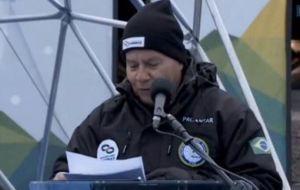MercoPress. South Atlantic News Agency
Brazilian Antarctica base reopened from its ashes after eight years
 The new station cost about US$ 100 million.
The new station cost about US$ 100 million.Brazil Wednesday reopened its scientific Comandante Ferraz base in Antarctica, which had been destroyed in a fire in 2012. In the incident two soldiers died and more than two thirds of the facilities were destroyed.
Vice President Hamilton Mourão delivered the main speech on behalf of President Jair Bolsonaro during a ceremony which had to be rescheduled due to bad weather keeping the officials from arriving on time.
“The new facilities represent the advance in the presence of Brazil in this continent and a qualitative advance in the federal government's commitment to the development of scientific activities linked to scientific and environmental issues,” said Mourão.
The new base, located on King George Island, in the South Shetland archipelago, cost the federal government about US$ 100 million, according to government sources, and covers an area of 4,500 square meters, almost twice as large as the old base. The new building is located on the Admiralty Bay was built by the Chinese company CEIEC (China National Electronics Import and Export Corporation).
The opening ceremony started at 8:30 p.m. Brasilia time. Besides Mourão the Ministers of Defense, General Fernando Azevedo e Silva, and of Science, Technology, Innovations and Communications, Marcos Pontes, and Infrastructure, Tarcísio Gomes de Freitas were present, among other authorities.
First to speak was Brazilian Navy Chief Admiral Ilques Barbosa, who stressed that the architectural project of the new base was prepared by Brazilians following rigorous sustainability criteria. He also thanked CEIEC for the successful joint work.
Barbosa highlighted “Brazil's commitment as an advisory member of the Antarctic Treaty to participate in decisions about the future of this region.”
He added that “Ferraz represents the maintenance of our active presence in this continent. Brazil is with a new house in Antarctica, welcome everyone.”
The launch of a weather balloon by a researcher at the Federal University of Minas Gerais marked the symbolic start of scientific activities in the new Brazilian station.
Subsequently, a provisional term for receiving the facilities between Admiral Barbosa and the president of CEIEC, Qu Huimin, was signed.
The ceremony peaked with Mourão's speech. The Vicepresident underlined the new base will be at the service of the development of science and international cooperation, characterizing “the advancement of Brazil's presence in this southern continent”.
Although the formalities were still pending, different investigations have been already under way in the new base since November 2019.
Designed by the Brazilian architecture firm Estúdio 41, the unit stands out for its elegant appearance and hotel-style accommodation for up to 64 people, including scientists and military personnel.
Seventeen laboratories - fourteen internal and three external - will support research in a variety of fields, from environmental microbiology to human physiology, paleontology and climate change.
“It's a first-class facility, really spectacular in many ways,” says Wim Degrave, molecular biologist and biotechnology specialist at the Oswaldo Cruz Foundation who visited the station in November 2019.
However, representatives of the Brazilian scientific community have expressed doubts regarding the operational future of the base, based on the budgetary restrictions prevailing in the Bolsonaro administration.
In any case, the new Comandante Ferraz is considered “the best research structure in the Antarctic Peninsula,” Brazilian Admiral Sérgio Gago Guida said in an interview with EFE.
The building is organized into two low-rise blocks, held through pillars capable of withstanding the effects of the melting of Antarctica, where the lowest temperatures on the planet and winds of up to three hundred kilometers per hour are recorded.
“Brazil is a tropical country, so we were not used to these conditions. It was an engineering project carried out by a team of architects,” Efe Emerson Vidigal, one of the architects in charge of the project, told Efe.
“Our central premise was to guarantee the survival and comfort of the human being in this inhospitable place,” he added.
The architecture studio began working on the project in 2013, but it was not until the end of 2015 when the works of the station began, after the Chinese construction company Ceiec won the international competition.
The foundations of the complex were first assembled in Shanghai and, as of 2017, they were transported to King George Island, which explains that half of the total financial cost of the new base, estimated at about US $ 100 million, was destined to the transport and logistics of it.
The architectural project managed to combine the response of scientific requirements and respect for the environment, as technologies aimed at minimizing environmental impact were a priority.
Specifically, 30% of the station's energy is renewable, in addition to “respecting the local fauna and flora.”
But beyond efficiency, durability and energy use, the architects managed to move the aesthetics on this base, whose design includes large crystals that connect the building with the landscape of the coldest area of the planet.
The study, in the hands of professors Paulo Câmara, from the University of Brasilia, and Luiz Henrique Rosa, from the Federal University of Minas Gerais, focused on the analysis of the DNA of Antarctic plants and fungi.





Top Comments
Disclaimer & comment rulesCommenting for this story is now closed.
If you have a Facebook account, become a fan and comment on our Facebook Page!